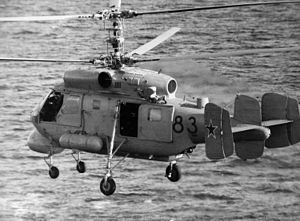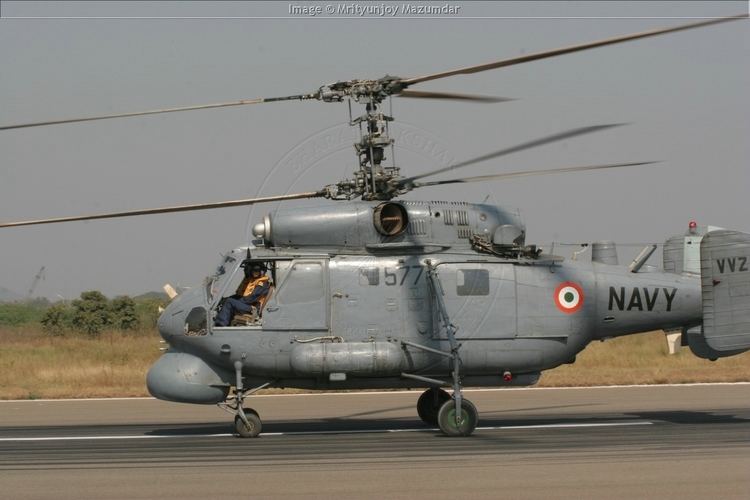Wingspan 16 m Engine type Turboshaft Designer Nikolay Kamov | Length 9.75 m Manufacturer Kamov | |
 | ||
The Kamov Ka-25 (NATO reporting name 'Hormone') was a naval helicopter, developed for the Soviet Navy in the USSR from 1958.
Contents

Kamov ka 25
Design and development
In the late 1950s there was an urgent demand for anti-submarine helicopters for deployment on new ships equipped with helicopter platforms entering service with the Soviet Navy. Kamov's compact design was chosen for production in 1958. To speed the development of the new anti-submarine helicopter Kamov designed and built a prototype to prove the cabin and dynamic components layout; designated Ka-20, this demonstrator was not equipped with mission equipment, corrosion protection or shipboard operational equipment. The Ka-20 was displayed at the 1961 Tushino Aviation Day display.
Definitive prototypes of the Ka-25 incorporated mission equipment and corrosion protection for the structure. The rotor system introduced aluminium alloy blades pressurised with nitrogen for crack detection, lubricated hinges, hydraulic powered controls, alcohol de-icing and automatic blade folding. Power was supplied by two free-turbine engines sat atop the cabin, with electrically de-iced inlets, plain lateral exhausts with no Infra-Red countermeasures, driving the main gearbox directly and a cooling fan for the gearbox and hydraulic oil coolers aft of the main gearbox. Construction was of stressed skin duralumin throughout with flush-riveting, as well as some bonding and honeycomb sandwich panels. The 1.5m × 1,25m × 3.94m cabin had a sliding door to port flight deck forward of the cabin and fuel tanks underfloor filled using a pressure refueling nozzle on the port side. A short boom at the rear of the cabin had a central fin and twin toed in fins at the ends of the tailplane mainly for use during auto-rotation. The undercarriage consisted of two noncastoring mainwheels with sprag brakes attached to the fuselage by parallel 'V' struts with a single angled shock absorber to dissipate landing loads, and two castoring nosewheels on straight shock absorbing legs attached directly to the fuselage either side of the cockpit which folded rearwards to reduce interference with the RADAR, all wheels were fitted with emergency rapid inflation flotation collars. Flying controls all act on the co-axial rotors with pitch, roll and collective similar to a conventional single rotor helicopter. Yaw was through differential collective which has a secondary effect of torque, an automatic mixer box ensured that total lift on the rotors remained constant during yaw maneuvers, to improve handling during deck landings. Optional extras included fold up seats for 12 passengers, rescue hoist, external auxiliary fuel tanks or containers for cameras, flares, smoke floats or beacons.
Variants


Operators
Specifications (Ka-25BSh)
Data from
General characteristics
Performance
Armament
1,900 kg (4,189 lb) of disposable stores
